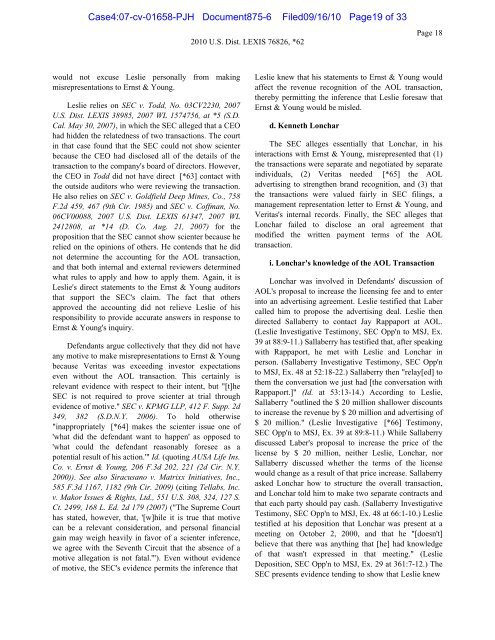exhibit 2 - SAP Lawsuit Portal
exhibit 2 - SAP Lawsuit Portal
exhibit 2 - SAP Lawsuit Portal
You also want an ePaper? Increase the reach of your titles
YUMPU automatically turns print PDFs into web optimized ePapers that Google loves.
Case4:07-cv-01658-PJH Document875-6 Filed09/16/10 Page19 of 33<br />
would not excuse Leslie personally from making<br />
misrepresentations to Ernst & Young.<br />
Leslie relies on SEC v. Todd, No. 03CV2230, 2007<br />
U.S. Dist. LEXIS 38985, 2007 WL 1574756, at *5 (S.D.<br />
Cal. May 30, 2007), in which the SEC alleged that a CEO<br />
had hidden the relatedness of two transactions. The court<br />
in that case found that the SEC could not show scienter<br />
because the CEO had disclosed all of the details of the<br />
transaction to the company's board of directors. However,<br />
the CEO in Todd did not have direct [*63] contact with<br />
the outside auditors who were reviewing the transaction.<br />
He also relies on SEC v. Goldfield Deep Mines, Co., 758<br />
F.2d 459, 467 (9th Cir. 1985) and SEC v. Coffman, No.<br />
06CV00088, 2007 U.S. Dist. LEXIS 61347, 2007 WL<br />
2412808, at *14 (D. Co. Aug. 21, 2007) for the<br />
proposition that the SEC cannot show scienter because he<br />
relied on the opinions of others. He contends that he did<br />
not determine the accounting for the AOL transaction,<br />
and that both internal and external reviewers determined<br />
what rules to apply and how to apply them. Again, it is<br />
Leslie's direct statements to the Ernst & Young auditors<br />
that support the SEC's claim. The fact that others<br />
approved the accounting did not relieve Leslie of his<br />
responsibility to provide accurate answers in response to<br />
Ernst & Young's inquiry.<br />
Defendants argue collectively that they did not have<br />
any motive to make misrepresentations to Ernst & Young<br />
because Veritas was exceeding investor expectations<br />
even without the AOL transaction. This certainly is<br />
relevant evidence with respect to their intent, but "[t]he<br />
SEC is not required to prove scienter at trial through<br />
evidence of motive." SEC v. KPMG LLP, 412 F. Supp. 2d<br />
349, 382 (S.D.N.Y. 2006). To hold otherwise<br />
"inappropriately [*64] makes the scienter issue one of<br />
'what did the defendant want to happen' as opposed to<br />
'what could the defendant reasonably foresee as a<br />
potential result of his action.'" Id. (quoting AUSA Life Ins.<br />
Co. v. Ernst & Young, 206 F.3d 202, 221 (2d Cir. N.Y.<br />
2000)). See also Siracusano v. Matrixx Initiatives, Inc.,<br />
585 F.3d 1167, 1182 (9th Cir. 2009) (citing Tellabs, Inc.<br />
v. Makor Issues & Rights, Ltd., 551 U.S. 308, 324, 127 S.<br />
Ct. 2499, 168 L. Ed. 2d 179 (2007) ("The Supreme Court<br />
has stated, however, that, '[w]hile it is true that motive<br />
can be a relevant consideration, and personal financial<br />
gain may weigh heavily in favor of a scienter inference,<br />
we agree with the Seventh Circuit that the absence of a<br />
motive allegation is not fatal.'"). Even without evidence<br />
of motive, the SEC's evidence permits the inference that<br />
2010 U.S. Dist. LEXIS 76826, *62<br />
Leslie knew that his statements to Ernst & Young would<br />
affect the revenue recognition of the AOL transaction,<br />
thereby permitting the inference that Leslie foresaw that<br />
Ernst & Young would be misled.<br />
d. Kenneth Lonchar<br />
Page 18<br />
The SEC alleges essentially that Lonchar, in his<br />
interactions with Ernst & Young, misrepresented that (1)<br />
the transactions were separate and negotiated by separate<br />
individuals, (2) Veritas needed [*65] the AOL<br />
advertising to strengthen brand recognition, and (3) that<br />
the transactions were valued fairly in SEC filings, a<br />
management representation letter to Ernst & Young, and<br />
Veritas's internal records. Finally, the SEC alleges that<br />
Lonchar failed to disclose an oral agreement that<br />
modified the written payment terms of the AOL<br />
transaction.<br />
i. Lonchar's knowledge of the AOL Transaction<br />
Lonchar was involved in Defendants' discussion of<br />
AOL's proposal to increase the licensing fee and to enter<br />
into an advertising agreement. Leslie testified that Laber<br />
called him to propose the advertising deal. Leslie then<br />
directed Sallaberry to contact Jay Rappaport at AOL.<br />
(Leslie Investigative Testimony, SEC Opp'n to MSJ, Ex.<br />
39 at 88:9-11.) Sallaberry has testified that, after speaking<br />
with Rappaport, he met with Leslie and Lonchar in<br />
person. (Sallaberry Investigative Testimony, SEC Opp'n<br />
to MSJ, Ex. 48 at 52:18-22.) Sallaberry then "relay[ed] to<br />
them the conversation we just had [the conversation with<br />
Rappaport.]" (Id. at 53:13-14.) According to Leslie,<br />
Sallaberry "outlined the $ 20 million shallower discounts<br />
to increase the revenue by $ 20 million and advertising of<br />
$ 20 million." (Leslie Investigative [*66] Testimony,<br />
SEC Opp'n to MSJ, Ex. 39 at 89:8-11.) While Sallaberry<br />
discussed Laber's proposal to increase the price of the<br />
license by $ 20 million, neither Leslie, Lonchar, nor<br />
Sallaberry discussed whether the terms of the license<br />
would change as a result of that price increase. Sallaberry<br />
asked Lonchar how to structure the overall transaction,<br />
and Lonchar told him to make two separate contracts and<br />
that each party should pay cash. (Sallaberry Investigative<br />
Testimony, SEC Opp'n to MSJ, Ex. 48 at 66:1-10.) Leslie<br />
testified at his deposition that Lonchar was present at a<br />
meeting on October 2, 2000, and that he "[doesn't]<br />
believe that there was anything that [he] had knowledge<br />
of that wasn't expressed in that meeting." (Leslie<br />
Deposition, SEC Opp'n to MSJ, Ex. 29 at 361:7-12.) The<br />
SEC presents evidence tending to show that Leslie knew


